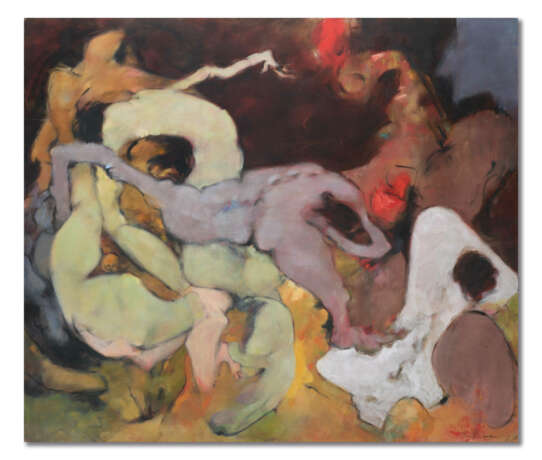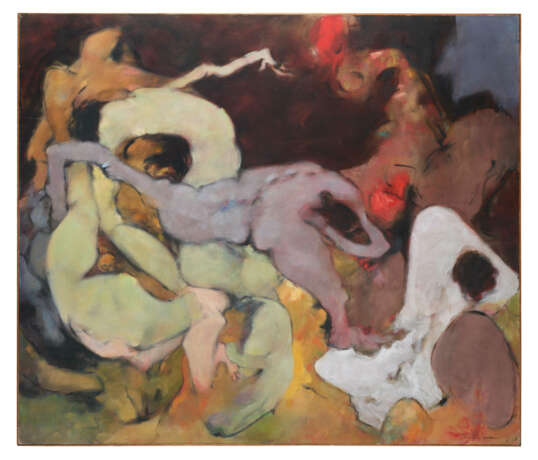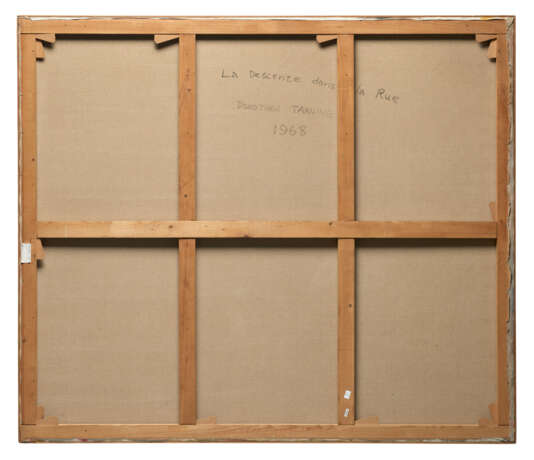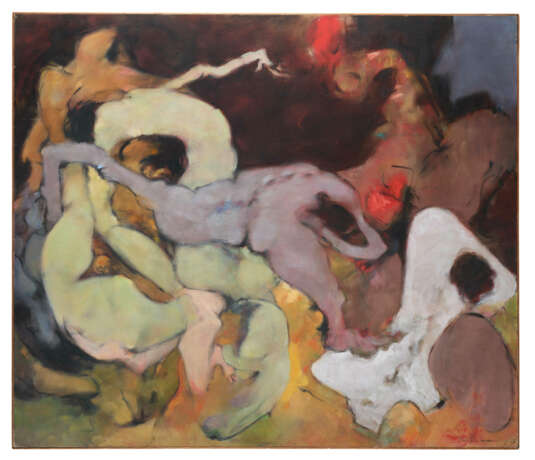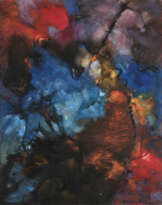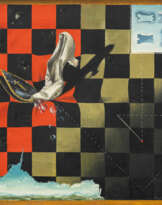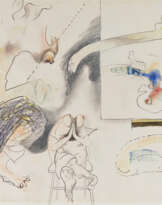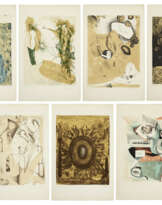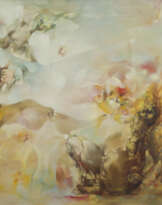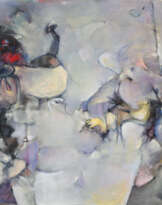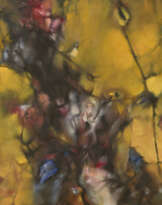ID 1053103
Lot 335 | Dorothea Tanning (1910-2012)
Valeur estimée
€ 200 000 – 300 000
La Descente dans la rue
signé et daté 'Dorothea Tanning 68' (en bas à droite); signé, daté et inscrit 'La Descente dans la Rue DOROTHEA TANNING 1968' (au revers)
huile sur toile
172.2 x 201 cm.
Peint en 1968
signed and dated 'Dorothea Tanning 68' (lower right); signed, dated and inscribed 'La Descente dans la Rue DOROTHEA TANNING 1968' (on the reverse)
oil on canvas
67 5⁄8 x 79 ¼ in.
Painted in 1968
Provenance
Alain Jouffroy, France (don de l'artiste).
Puis par descendance au propriétaire actuel.
Literature
P. Waldberg, Dorothea Tanning, La Mémoire Ensorcelée, Paris, 1966, p. 329.
Die Welt, No. 129, mai 1968, p. 11 (illustré).
G. Plazy, ‘La Libération de Dorothea Tanning’, in Le Quotidien de Paris, No. 48, 30 mai 1974, p. 12.
A. Jouffroy, ‘Dorothea Tanning, Le Chavirement dans la joie’, in XXe Siècle, No. 43, décembre 1974 (illustré, p. 62).
A. Jouffroy, ‘L’Attentat de Dorothea Tanning’, in XXe Siècle, Numéro Spécial, 1977, p. 26 (illustré).
P. Waldberg, ‘La belle dormeuse aux abois’, in XXe Siècle, Numéro Spécial, 1977, p. 44 (illustré).
R. Lebel, ‘Un Signal et un aveu’, in XXe Siècle, Numéro Spécial, 1977, p. 74.
J.-C. Bailly et R. C. Morgan, Dorothea Tanning, New York, 1995 (illustré en couleurs, pl. 88).
K. Conley, ‘Les révolutions de Dorothea Tanning’ in Pleine Marge, Cahiers de littérature, d’arts plastiques & de critique, No. 36, décembre 2002, p. 162.
Dorothea Tanning, Behind the Door, Another Invisible Door, cat. exp., Museo Nacional Centro de Arte Reina Sofía, Madrid et Tate Modern, Londres, 2018, p. 74.
J. Pech, Max Ernst, D-paintings, Zeitreise der Liebe, cat. exp., Max Ernst Museum, Brühl, 2019, p. 203 (illustré in situ dans l'atelier de l'artiste).
V. Carruthers, Dorothea Tanning, Transformations, Londres, 2020, p. 143, no. 119 (illustré en couleurs, p. 142).
Exhibited
Paris, Musée d'Art Moderne de la Ville de Paris, 24ème Salon de Mai, mai 1968, no. 206.
Hambourg, Kunstverein, Malerei des Surrealismus von den Anfängen bis heute, avril-mai 1969, no. 118 (illustré, fig. 114).
Paris, Centre National d’Art Contemporain, Dorothea Tanning, Œuvre, mai-juillet 1974, no. 65.
Genève, Galerie Jan Krugier, Dorothea Tanning, novembre-décembre 1974, no. 18 (illustré).
Malmö, Konsthall, Dorothea Tanning, Om Konst Kunde Tala (If Art Could Talk), avril-mai 1993, p. 58-59 (illustré, p. 58 et illustré en couleurs, p. 89).
Further details
Des corps se mêlent dans une danse envoûtante à la surface de La Descente dans la rue. Peint en 1968, ce tableau monumental et tout à fait saisissant de Dorothea Tanning est une incursion kaléidoscopique dans la couleur, où le bleu lavande part à la rencontre de blancs laiteux, de jaunes chatoyants et de quelques éclats rouge vif. Très expressif et d'une grande spontanéité, ici, le geste ondulant de l'artiste fait naître un ballet de formes hypnotiques dont les contours tremblotants, presque liquéfiés, aimantent le regard.
Lorsque Tanning conçoit La Descente dans la rue, elle a tourné depuis longtemps la page du surréalisme, mouvement qui l'avait rendue célèbre et grâce auquel son art s'était ouvert « à un champ illimité de POSSIBLES » (D. Tanning in A. Mahon, ‘Dorothea Tanning: Behind the Door, Another Invisible Door’ in Dorothea Tanning, cat. exp., Madrid, 2018, p. 19). Entre-temps, les scènes étranges, profondément fantastiques qui avaient dominé sa production des années 1930-40 ont cédé la place à un style beaucoup plus fluide, aux accents abstraits, quoique toujours fondamentalement figuratif. Une évolution radicale que Tanning décrit ainsi : « Vers 1955, mes toiles ont littéralement volé en éclats. Les couleurs sont sorties du placard, si l'on peut dire, pour arrondir les angles et les montrer sous un jour nouveau. C'était des surfaces prismatiques sur lesquelles je dissimulais, suggérais, lâchais mes éternels motifs et préoccupations, pour raconter toujours les même choses, d'une manière comme il y en a mille autres de les dire » (D. Tanning, Between Lives, An Artist and Her World, New York, 2001, p. 178).
Vers la fin des années 1960, au moment où elle travaille sur La Descente dans la rue, Tanning commence par ailleurs à créer des sculptures souples en tissu, dont les volumes contorsionnés évoquent des sortes de créatures sous-marines aux gueules béantes. Ce même sens de la matérialité semble émaner de l'entrelacs de silhouettes mouvantes et tout enchevêtrées de la présente œuvre. Selon la théoricienne de l'art Alison Rowley, dans les toiles de ces années-là, Tanning « tente de bâtir un espace pictural qui puisse abriter simultanément les sens du toucher et de la vue, tels qu'on les ressent dans sa chair » (A. Rowley, ‘Lapses of Taste, On Dorothea Tanning’, Women’s Art Magazine, No. 66, octobre 1995, p. 18). Avec ses méandres de pigments qui dégagent quelque chose de charnel et de très tactile, La Descente dans la rue est le parfait exemple de cette recherche multi-sensorielle.
Ce tableau a autrefois appartenu à Alain Jouffroy, poète, critique, écrivain et défenseur invétéré du surréalisme. Grand admirateur de l'œuvre de Tanning, il a consacré de nombreux écrits à son travail et ses expositions. L'artiste lui accordait en mars 1974 une interview à partir de laquelle est d'ailleurs née toute l'idée d'une rétrospective, présentée en 2018 au Museo Nacional Centro de Arte Reina Sofía de Madrid et à la Tate Modern de Londres. Pour Jouffroy, quelque chose de prodigieux naît au contact de l'art de Tanning. « Lorsque je regarde une toile de Dorothea, je n'en suis pas le spectateur, mais l'acteur » (A. Jouffroy, ‘L’Attentat de Dorothea Tanning’, in XXe Siècle, Numéro Spécial, 1977, p. 16).
Dans son entretien de 1974 avec Tanning, Jouffroy aborde spécifiquement la question de La Descente dans la rue :
« Alain Jouffroy: En 1968, peu avant mai, vous avez peint La Descente dans la rue. Votre peinture est-elle liée à un certain pressentiment de ce qui va, de ce qui peut arriver? Dans quel domaine?
Dorothea Tanning: Quand j'étais étudiante je lisais J.B. Rhine sur ses expériences à la Duke University, avec la télépathie et la ‘extra-sensory perception’. Ça me passionnait. Et je pense toujours qu'à condition d'être dans un état utra-réceptif on peut non seulement transmettre ses pensées à un autre, mais on peut aussi capter les ondes de l'avenir. L'état ultra-réceptif en question est si tendu, si haut, comme un son inaudible que ça se passe dans le subconscient (sur-conscient ?). Et c'est ainsi qu'on a le vulgaire sentiment de surprise quand un événement coïncide parfaitement avec un souvenir. Quant à ma peinture, c'est mon cristal. On veut, devant chaque toile blanche, mais c'est à chaque fois une affaire de grande gravité, on doit absolument provoquer l'apparition. L'apparition est l'événement. Moi, je ne peux pas concevoir la peinture autrement. Ni la voir moins terrifiante si elle reste création. Mais ça c'est une autre histoire. » (‘Questions pour Dorothea Tanning, Entretien avec Alain Jouffroy, Mars 1974’, in Dorothea Tanning, Oeuvre, cat. exp., Paris, Centre National d’Art Contemporain, 1974, p. 48-49).
A tangle of bodies dances across Dorothea Tanning’s monumental and stunning La Descente dans la rue. Painted in 1968, the work is a kaleidoscopic study in colour, filled with lavender, milky white, glimmering yellows, and flashes of vivid red. Here, Tanning’s brushwork is gestural and painterly, the result of which is a trembling, almost aqueous pictorial surface that beguiles the eye.
Though often associated with Surrealism, by the time La Descente dans la rue was painted, Tanning’s practice had diverged from the modernist movement that first revealed to her ‘the limitless expanse of POSSIBILITY’ (D. Tanning quoted in A. Mahon, ‘Dorothea Tanning, Behind the Door, Another Invisible Door’ in Dorothea Tanning, exh. cat., Madrid, 2018, p. 19). Instead of the uncanny, fantastical scenes she had created throughout the 1930s and 1940s, her imagery became less representational and freer – though she never truly abandoned the figure. As the artist later recounted, ‘Around 1955, my canvases literally splintered. Their colours came out of the closet, you might say, to open the rectangles to a different light. They were prismatic surfaces where I veiled, suggested and floated my persistent icons and preoccupations, in another of the thousand ways of saying the same things’ (D. Tanning, Between Lives, An Artist and Her World, New York, 2001, p. 178).
By the late-1960s, when Tanning was working on Descente dans la rue, she began to experiment with soft sculpture, and her three-dimensional forms conjured images of gaping maws, undersea creatures, and writhing bodies. Such physicality is invoked in the supple, entwined forms of the present work; as the cultural theorist Alison Rowley has argued, in the canvases of these years, Tanning ‘attempt[ed] a construction of pictorial space that can accommodate simultaneous sensations of sighi and touch as experienced by the body’ (A. Rowley, ‘Lapses of Taste, On Dorothea Tanning’, in Women’s Art Magazine, No. 66, October 1995, p. 18). Indeed, La Descente dans la rue is a tactile, carnal painting that calls out for a multisensorial engagement.
La Descente dans la rue was previously owned by Alain Jouffroy, the celebrated poet and writer who championed Surrealism. Jouffroy also regularly wrote about and reviewed Tanning’s exhibitions. In March of 1974, he interviewed the artist, and the conceptual framework of Tanning’s 2018 retrospective, held at the Museo Nacional Centro de Arte Reina Sofía, Madrid, and Tate Modern, London, was inspired by this conversation. For Jouffroy, the experience of Tanning’s art was formidable. As he wrote, ‘When I look at a painting by Dorothea, I am not a spectator, but an actor’ (A. Jouffroy, ‘L’Attentat de Dorothea Tanning’, in XXe Siècle, Numéro Spécial, 1977, p. 16).
During the 1974 interview, Jouffroy questioned Tanning specifically about this work La Descente dans la rue:
"Alain Jouffroy: In 1968, shortly before May, you painted La Descente dans la rue (The Mob bursts into the street). Is this painting connected to some foreboding for what was going to happen, what might happen? In what domain?
"Dorothea Tanning: Something of the sort, yes. When I was in college, I read J.B. Rhine on his experiments at Duke University with telepathy and extra-sensory perception. I was fascinated. And I still think that, in an ultra-receptive state you can not only communicate your thoughts to someone else, you can also capture vibrations of the future. The ultra-receptive state in question is so tense, so high, like a subliminal sound, that it takes place in your subconscious (surconscious?). That's why there is this trivial feeling of surprise when some event perfectly matches a memory. As for painting -- it's my crystal. In front of any blank canvas I try -- but it is always a matter of great seriousness -- to provoke the apparition. My own event. I, for one, can't approach painting otherwise." (‘Interview with Dorothea Tanning’ in Dorothea Tanning, exh. cat., Malmö, 1993, p. 59).
| Artiste: | Dorothea Tanning (1910 - 2012) |
|---|---|
| Technique appliquée: | Huile sur toile |
| Catégorie maison de vente aux enchères: | Peintures |
| Artiste: | Dorothea Tanning (1910 - 2012) |
|---|---|
| Technique appliquée: | Huile sur toile |
| Catégorie maison de vente aux enchères: | Peintures |
| Adresse de l'enchère |
CHRISTIE'S 9 Avenue Matignon 75008 Paris France | ||||||||||||||
|---|---|---|---|---|---|---|---|---|---|---|---|---|---|---|---|
| Aperçu |
| ||||||||||||||
| Téléphone | +33 (0)1 40 76 85 85 | ||||||||||||||
| Fax | +33 (0)1 40 76 85 86 | ||||||||||||||
| Conditions d'utilisation | Conditions d'utilisation | ||||||||||||||
| transport |
Service postal Service de messagerie ramassage par vous-même | ||||||||||||||
| Modes de paiement |
Virement bancaire | ||||||||||||||
| Heures d'ouverture | Heures d'ouverture
|
